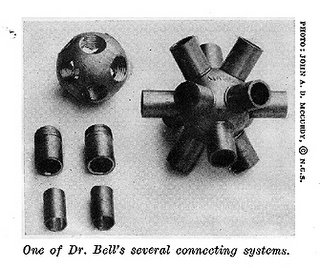
Twas my good fortune, and Lindsey's, to hang with Sam Lanahan yesterday evening. His flextegrity invention has been a feature before in these blogs, as well as in my Photostream where I've chronicled additional meetings, including with Trevor and D.W. Jacobs (at this same fish house).
Back at his pad, Sam and I watched Monday night football (Saints winning against Patriots) in high def while discussing various matters. He's taking another shipment from China soon, a version 6 of his prototype.
Sam's work relates to Alexander Graham Bell's around the octet truss, as we later came to call it (based on Fuller's patent).
Whereas Bell's designs held the main hubs in place by rods running perpendicular to what would be their planes of inter-tangency -- were they to grow into space-filling rhombic dodecahedra -- Sam's 3-piece solutions hold the hubs together by more ingenious curvaceous arms, taut bands, other schemes of his own devising, none the less up to load bearing duties. Sam's hubs are icosahedral, not spheres, for maximal robustness.
 Sam reminds me of Santa Claus, but with just the one toy, a good one, in many versions (and not really just a toy). So maybe one of Santa's elves?
Sam reminds me of Santa Claus, but with just the one toy, a good one, in many versions (and not really just a toy). So maybe one of Santa's elves?Speaking of rhombic dodecahedra shrink-wrapping those IVM spheres, volume six each, I took Sam on a tour of some recent work on Wikieducator and edu-sig publicizing these T,E,K-modular studies, both in extended precision decimal and with turtle graphics (my thanks to Gregor in Vienna for help with the latter).
The T, you'll recall, has the same volume as the A and B modules, which assemble said space-filling dodecahedra. 120 Ts assemble the volume 5 rhombic triacontahedron (30 diamonds) which hugs the sphere more closely. I showed Sam that picture from Synergetics 2 about just how close the T's radius comes to 1 on the nose (he had his copy close at hand, good design scientist that he be).
Why we don't have more entertainingly technical shows on TV is beyond me. National Geographic channel is good, but their piece on DARPA (the Lockheed skunkworks in particular) was somewhat knuckle-draggy, the usual "deliver the payload to the enemy anywhere in the world within 20 minutes" shock and awe kinda stuff, ethnic and droll, nocturnal emissions from some sorry-ass empire (shoddy screen writing, bloated budget).
We should show more pride in civilian technology if we get around to an Oregon-based version. Outward weaponry is by definition dark ages, given the coolest killingry is all virtual by now (did I mention Les had climbed to within the top 200 on Evony, out of more than half a million players?). Cyberspace is where the action is.
I'm always revisiting the Bruce Adams nightmare around why civilizations fail (maybe ours in this way?). We get so secretive and paranoid about laymen and/or "the competition" getting a sneak peak at some insider view, that we keep a whole next generation in the dark, sometimes too much in the dark to have any hope for a positive future. They turn cynical and distopian, give up seeking rewarding careers, resort to fighting a losing game whereas it might have been more fun to advance this civilization (if given a real chance).
You won't recruit a new generation of engineers if you refuse to strut your stuff, show us what you've got, explain how it works to some enlightening degree.
Television works well for this. Maybe on a weekly schedule? ISEPP TV? Portland Knowledge Lab? Focus on our own industries, challenges, entrepreneurs. Tim's electric car. Nanotechnology. Fab. Martian Math Etc.
We'd need lots of technical toons, animations i.e. interesting clips for which the world has an appetite, a kind of advertising in some cases.
We should get busy.

